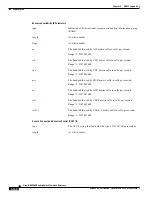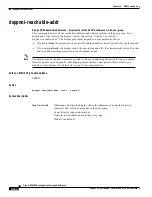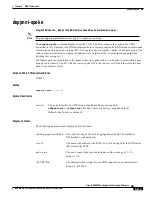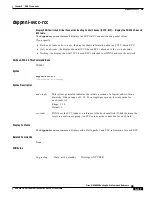
5-109
Cisco MGX 8850 Routing Switch Command Reference
Release 2.0, Part Number 78-10467-04 Rev C0, October 2001
Chapter 5
PNNI Commands
dsppnni-routing-policy
Display Contents
This section lists the displayed information for each node. The display shows the configuration that
results from cnfpnni-routing-policy.
SPT epsilon
This parameter is meaningful primarily for crankback. The epsilon you supply
specifies a tolerance in the form of a percent that can influence which paths
qualify as equal-cost during route calculation. A higher tolerance results in a
broader range of path cost-values that can qualify as equal-cost. If two paths
have very similar administrative weights (AWs), a large enough tolerance
eliminates equal-cost as a routing factor because the routing algorithm regards
the costs as equal.
The range of 0–20 for this parameter comes from the ATM Forum PNNI
specification. However, the percent of tolerance that the numbers dictate is
determined by individual vendors. Cisco Systems currently maps the
following percentages for the Cisco MGX 8850 switch:
0: the total AWs along both directions of the path must be identical.
1-2: the total AWs along both directions of the path must be within 1.06%
3-4: the total AWs along both directions of the path must be within 3.125%
5-9: the total AWs along both directions of the path must be within 6.25%
10-15: the total AWs along both directions of the path must be within 12.5%
16-20: the total AWs along both directions of the path must be within 25.0%
Range: 0–20
Default: 0, so only identical path-cost values qualify as equal-cost
Load balance
The load balancing rule if any alternative, equal-cost routes exist for a given
call request.
random = requires the least overhead due to minimal calculation. Best choice
when selecting between paths that have similar available bandwidth.
maxbw = requires the most overhead due to ongoing comparison of available
bandwidth on paths. Best choice when selecting between paths with dissimilar
or fluctuating bandwidth.
SPT holddown time
Minimum time between consecutive calculations that generate routing tables.
Units: 100 millisecond increments
Range: 1–600 (0.1–60 seconds)
















































